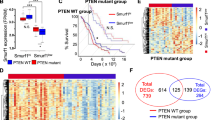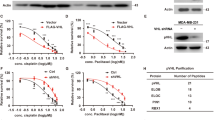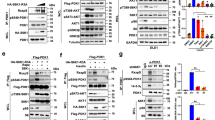Abstract
The cyclin-dependent kinase inhibitor p27 is a key regulator of cell-cycle progression. Its expression and localization are altered in several types of malignancies, which has prognostic significance in cancers such as renal cell carcinoma (RCC). S-phase kinase-associated protein 2 (SKP-2) is an F-box protein that is part of the SKP-1/Cul1/F-box ubiquitin ligase complex that targets nuclear p27 among many other cell-cycle proteins for proteosomal degradation. Its overexpression has been observed in several tumor types. Signaling by phosphoinositide 3-kinase (PI3K)/protein kinase B (AKT) has previously been shown to regulate the SKP-2/p27 axis. Recent evidence suggests that PI3K signaling may activate mammalian target of rapamycin complex 2 (mTORC2) activity. As PI3K signaling is known to regulate SKP-2 and p27, we sought to determine whether these effects were mediated by mTORC2. Here we provide additional genetic evidence that PI3K signaling activates mTORC2 kinase activity. We also demonstrate a novel role for mTORC2 in the modulation of nuclear p27 levels. In particular, mTORC2 signaling promotes the reduction of nuclear p27 protein levels through the increased protein expression of SKP-2. These are the first data to demonstrate a role for mTOR in the regulation of SKP-2. In concordance with these findings, mTORC2 activity promotes cell proliferation of RCC cells at the G1–S interphase of the cell cycle. Collectively, these data implicate mTORC2 signaling in the regulation of the SKP-2/p27 axis, a signaling node commonly altered in cancer.
This is a preview of subscription content, access via your institution
Access options
Subscribe to this journal
Receive 50 print issues and online access
$259.00 per year
only $5.18 per issue
Buy this article
- Purchase on Springer Link
- Instant access to full article PDF
Prices may be subject to local taxes which are calculated during checkout








Similar content being viewed by others
References
Chu IM, Hengst L, Slingerland JM . The Cdk inhibitor p27 in human cancer: prognostic potential and relevance to anticancer therapy. Nature Rev Cancer 2008; 8: 253–267.
Anastasiadis AG, Calvo-Sanchez D, Franke KH, Ebert T, Heydthausen M, Schulz WA et al. p27KIP1-expression in human renal cell cancers: implications for clinical outcome. Anticancer Res 2003; 23: 217–221.
Haitel A, Wiener HG, Neudert B, Marberger M, Susani M . Expression of the cell cycle proteins p21, p27, and pRb in clear cell renal cell carcinoma and their prognostic significance. Urology 2001; 58: 477–481.
Hedberg Y, Davoodi E, Ljungberg B, Roos G, Landberg G . Cyclin E and p27 protein content in human renal cell carcinoma: clinical outcome and associations with cyclin D. Int J Cancer 2002; 102: 601–607.
Hedberg Y, Ljungberg B, Roos G, Landberg G . Expression of cyclin D1, D3, E, and p27 in human renal cell carcinoma analysed by tissue microarray. Br J Cancer 2003; 88: 1417–1423.
Langner C, von Wasielewski R, Ratschek M, Rehak P, Zigeuner R . Biological significance of p27 and Skp2 expression in renal cell carcinoma:a systematic analysis of primary and metastatic tumour tissues using a tissue microarray technique. Virchows Arch 2004; 445: 631–636.
Migita T, Oda Y, Naito S, Tsuneyoshi M . Low expression of p27(Kip1) is associated with tumor size and poor prognosis in patients with renal cell carcinoma. Cancer 2002; 94: 973–979.
Sgambato A, Camerini A, Genovese G, De Luca F, Viacava P, Migaldi M et al. Loss of nuclear p27(kip1) and alpha-dystroglycan is a frequent event and is a strong predictor of poor outcome in renal cell carcinoma. Cancer Sci 2010; 101: 2080–2086.
Kim J, Jonasch E, Alexander A, Short JD, Cai S, Wen S et al. Cytoplasmic sequestration of p27 via AKT phosphorylation in renal cell carcinoma. Clin Cancer Res 2009; 15: 81–90.
Stahl M, Dijkers PF, Kops GJ, Lens SM, Coffer PJ, Burgering BM et al. The forkhead transcription factor FoxO regulates transcription of p27Kip1 and Bim in response to IL-2. J Immunol 2002; 168: 5024–5031.
Vervoorts J, Luscher B . Post-translational regulation of the tumor suppressor p27(KIP1). Cell Mol Life Sci 2008; 65: 3255–3264.
Tsvetkov LM, Yeh KH, Lee SJ, Sun H, Zhang H . p27(Kip1) ubiquitination and degradation is regulated by the SCF(Skp2) complex through phosphorylated Thr187 in p27. Curr Biol 1999; 9: 661–664.
Sheaff RJ, Groudine M, Gordon M, Roberts JM, Clurman BE . Cyclin E-CDK2 is a regulator of p27Kip1. Genes Dev 1997; 11: 1464–1478.
Malek NP, Sundberg H, McGrew S, Nakayama K, Kyriakides TR, Roberts JM . A mouse knock-in model exposes sequential proteolytic pathways that regulate p27Kip1 in G1 and S phase. Nature 2001; 413: 323–327.
Alessi DR, James SR, Downes CP, Holmes AB, Gaffney PR, Reese CB et al. Characterization of a 3-phosphoinositide-dependent protein kinase which phosphorylates and activates protein kinase Balpha. Curr Biol 1997; 7: 261–269.
Stokoe D, Stephens LR, Copeland T, Gaffney PR, Reese CB, Painter GF et al. Dual role of phosphatidylinositol-3,4,5-trisphosphate in the activation of protein kinase B. Science 1997; 277: 567–570.
Frias MA, Thoreen CC, Jaffe JD, Schroder W, Sculley T, Carr SA et al. mSin1 is necessary for Akt/PKB phosphorylation, and its isoforms define three distinct mTORC2s. Curr Biol 2006; 16: 1865–1870.
Guertin DA, Stevens DM, Thoreen CC, Burds AA, Kalaany NY, Moffat J et al. Ablation in mice of the mTORC components raptor, rictor, or mLST8 reveals that mTORC2 is required for signaling to Akt-FOXO and PKCalpha, but not S6K1. Dev Cell 2006; 11: 859–871.
Yang Q, Inoki K, Ikenoue T, Guan KL . Identification of Sin1 as an essential TORC2 component required for complex formation and kinase activity. Genes Dev 2006; 20: 2820–2832.
Shiota C, Woo JT, Lindner J, Shelton KD, Magnuson MA . Multiallelic disruption of the rictor gene in mice reveals that mTOR complex 2 is essential for fetal growth and viability. Dev Cell 2006; 11: 583–589.
Gan X, Wang J, Su B, Wu D . Evidence for direct activation of mTORC2 kinase activity by phosphatidylinositol 3,4,5-trisphosphate. J Biol Chem 2011; 286: 10998–11002.
Tato I, Bartrons R, Ventura F, Rosa JL . Amino acids activate mammalian target of rapamycin complex 2 (mTORC2) via PI3K/Akt signaling. J Biol Chem 2011; 286: 6128–6142.
Kim EK, Yun SJ, Ha JM, Kim YW, Jin IH, Yun J et al. Selective activation of Akt1 by mammalian target of rapamycin complex 2 regulates cancer cell migration, invasion, and metastasis. Oncogene 2011; 30: 2954–2963.
Huang J, Dibble CC, Matsuzaki M, Manning BD . The TSC1-TSC2 complex is required for proper activation of mTOR complex 2. Mol Cell Biol 2008; 28: 4104–4115.
Toschi A, Lee E, Gadir N, Ohh M, Foster DA . Differential dependence of hypoxia-inducible factors 1 alpha and 2 alpha on mTORC1 and mTORC2. J Biol Chem 2008; 283: 34495–34499.
McDonald PC, Oloumi A, Mills J, Dobreva I, Maidan M, Gray V et al. Rictor and integrin-linked kinase interact and regulate Akt phosphorylation and cancer cell survival. Cancer Res 2008; 68: 1618–1624.
Thoreen CC, Kang SA, Chang JW, Liu Q, Zhang J, Gao Y et al. An ATP-competitive mammalian target of rapamycin inhibitor reveals rapamycin-resistant functions of mTORC1. J Biol Chem 2009; 284: 8023–8032.
Liu Z, Fu Q, Lv J, Wang F, Ding K . Prognostic implication of p27Kip1, Skp2 and Cks1 expression in renal cell carcinoma: a tissue microarray study. J Exp Clin Cancer Res 2008; 27: 51.
Saito K, Scharenberg AM, Kinet JP . Interaction between the Btk PH domain and phosphatidylinositol-3,4,5-trisphosphate directly regulates Btk. J Biol Chem 2001; 276: 16201–16206.
Lin HK, Wang G, Chen Z, Teruya-Feldstein J, Liu Y, Chan CH et al. Phosphorylation-dependent regulation of cytosolic localization and oncogenic function of Skp2 by Akt/PKB. Nat Cell Biol 2009; 11: 420–432.
Gao D, Inuzuka H, Tseng A, Chin RY, Toker A, Wei W . Phosphorylation by Akt1 promotes cytoplasmic localization of Skp2 and impairs APCCdh1-mediated Skp2 destruction. Nat Cell Biol 2009; 11: 397–408.
Bashir T, Pagan JK, Busino L, Pagano M . Phosphorylation of Ser72 is dispensable for Skp2 assembly into an active SCF ubiquitin ligase and its subcellular localization. Cell Cycle 2010; 9: 971–974.
Boutonnet C, Tanguay PL, Julien C, Rodier G, Coulombe P, Meloche S . Phosphorylation of Ser72 does not regulate the ubiquitin ligase activity and subcellular localization of Skp2. Cell Cycle 2010; 9: 975–979.
Wang H, Cui J, Bauzon F, Zhu L . A comparison between Skp2 and FOXO1 for their cytoplasmic localization by Akt1. Cell Cycle 2010; 9: 1021–1022.
Nogueira V, Sundararajan D, Kwan JM, Peng XD, Sarvepalli N, Sonenberg N et al. Akt-dependent Skp2 mRNA translation is required for exiting contact inhibition, oncogenesis, and adipogenesis. EMBO J 2012; 31: 1134–1146.
Guertin DA, Stevens DM, Saitoh M, Kinkel S, Crosby K, Sheen JH et al. mTOR complex 2 is required for the development of prostate cancer induced by Pten loss in mice. Cancer Cell 2009; 15: 148–159.
Gulhati P, Bowen KA, Liu J, Stevens PD, Rychahou PG, Chen M et al. mTORC1 and mTORC2 regulate EMT, motility, and metastasis of colorectal cancer via RhoA and Rac1 signaling pathways. Cancer Res 2011; 71: 3246–3256.
Masri J, Bernath A, Martin J, Jo OD, Vartanian R, Funk A et al. mTORC2 activity is elevated in gliomas and promotes growth and cell motility via overexpression of rictor. Cancer Res 2007; 67: 11712–11720.
Garcia-Martinez JM, Alessi DR . mTOR complex 2 (mTORC2) controls hydrophobic motif phosphorylation and activation of serum- and glucocorticoid-induced protein kinase 1 (SGK1). Biochem J 2008; 416: 375–385.
Cho DC, Cohen MB, Panka DJ, Collins M, Ghebremichael M, Atkins MB et al. The efficacy of the novel dual PI3-kinase/mTOR inhibitor NVP-BEZ235 compared with rapamycin in renal cell carcinoma. Clin Cancer Res 2010; 16: 3628–3638.
Sudarshan S, Sourbier C, Kong HS, Block K, Valera Romero VA, Yang Y et al. Fumarate hydratase deficiency in renal cancer induces glycolytic addiction and hypoxia-inducible transcription factor 1alpha stabilization by glucose-dependent generation of reactive oxygen species. Mol Cell Biol 2009; 29: 4080–4090.
Sarbassov DD, Guertin DA, Ali SM, Sabatini DM . Phosphorylation and regulation of Akt/PKB by the rictor-mTOR complex. Science 2005; 307: 1098–1101.
Huang J, Wu S, Wu CL, Manning BD . Signaling events downstream of mammalian target of rapamycin complex 2 are attenuated in cells and tumors deficient for the tuberous sclerosis complex tumor suppressors. Cancer Res 2009; 69: 6107–6114.
Acknowledgements
This work was supported in part by the Cancer Therapy and Research Center (CTRC) at the University of Texas Health Science Center (NIH P30 CA054174-17). SS is supported by NIH K08 CA138774, Voelcker Fund Young Investigator Award, AUA Foundation/Astellas Rising Star Award and a special gift from Mr Charles Butt and the employees of HEB. KB is supported by Veterans Administration Career Development Award (CDA-2) and NIH R01 NCI CA131272.We thank Z David Sharp for critical review of the manuscript. We thank William Friedrichs and Korri Weldon for technical assistance.
Author information
Authors and Affiliations
Corresponding author
Ethics declarations
Competing interests
The authors declare no conflict of interest.
Additional information
Supplementary Information accompanies the paper on the Oncogene website
Supplementary information
Rights and permissions
About this article
Cite this article
Shanmugasundaram, K., Block, K., Nayak, B. et al. PI3K regulation of the SKP-2/p27 axis through mTORC2. Oncogene 32, 2027–2036 (2013). https://doi.org/10.1038/onc.2012.226
Received:
Revised:
Accepted:
Published:
Issue Date:
DOI: https://doi.org/10.1038/onc.2012.226
Keywords
This article is cited by
-
Intact regulation of G1/S transition renders esophageal squamous cell carcinoma sensitive to PI3Kα inhibitors
Signal Transduction and Targeted Therapy (2023)
-
DAB2IP stabilizes p27Kip1 via suppressing PI3K/AKT signaling in clear cell renal cell carcinoma
Functional & Integrative Genomics (2023)
-
Multiple endocrine neoplasia type 4 (MEN4): a thorough update on the latest and least known men syndrome
Endocrine (2023)
-
The interplay between cell wall integrity and cell cycle progression in plants
Plant Molecular Biology (2023)
-
Heparanase modulates the prognosis and development of BRAF V600E-mutant colorectal cancer by regulating AKT/p27Kip1/Cyclin E2 pathway
Oncogenesis (2022)



